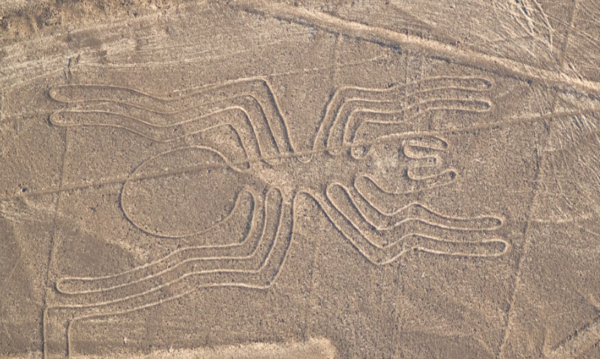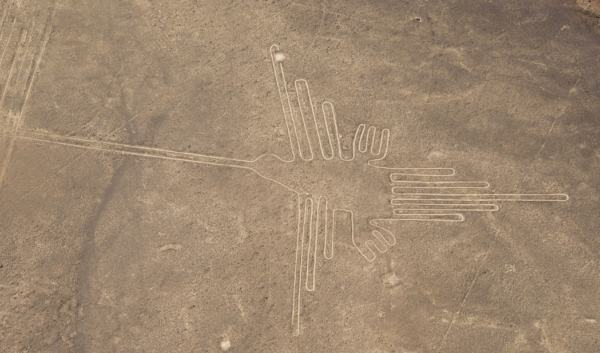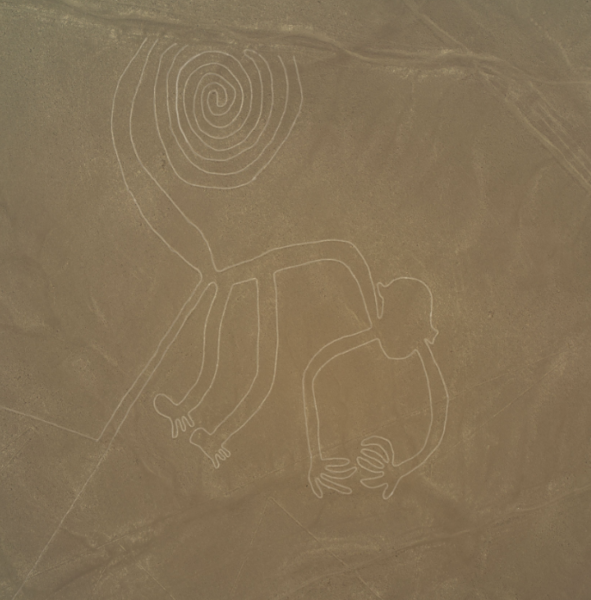In the mid-1500s, Spanish conquistador Pedro Cieza de Leon was chronicling his exploration of southern Peru and referred to strange trail markers he found in the soil of the Nazca Desert. In 1586, a separate report instead mentioned ancient ‘roads’ in the same area. These were the first discoveries of the Nazca Lines, although the explorers had no idea what they had found.
The Lines are a group of large geoglyphs formed by depressions and shallow incisions in the soil of the Nazca Desert and are said to have been created between 500 BC and 500 AD. While most lines run straight across the landscape, there are some which depict amazing designs of animals and plants. When you consider the size of these geoglyphs, each ranging from 0.4 to 1.1km across, and the date they were created, it is a truly remarkable feat.

The combined length of all the lines is over 1,300km (808 miles), whereas the group covers an area of approximately 50 sq.km (19 sq. miles). The depth of the lines are typically 10 to 15 cm, made by removing the top layer of pebbles to reveal a yellow-grey subsoil. Interestingly, the width of the lines changes dramatically across the whole group, with some measuring a third of a metre and others being as wide as 1.8m.
Visible from the surrounding foothills and the air, the shapes are usually made from one continuous line, varying in complexity. Hundreds are simply lines, some are more complicated geometric shapes. However, more than 70 are designs depicting different animals including a hummingbird, spider, fish, llama, jaguar, monkey, lizard, dog and even a human. Other shapes include trees and flowers. It is because of the isolation and dry climate of the plateau that the lines have been preserved so well, however it seems a shame that an influx of squatters in recent years has caused the Lines to deteriorate.
In 2011, a Japanese team from Yamagata University discovered two new small figures amongst the Nazca Lines, one of which resembled a human head and the other an animal. They were dated to the early period of the Nazca culture. In 2012, the university opened a research centre at the site to study the Lines and the surrounding region for a 15-year project. They have already identified nearly 100 new geoglyphs.
American historian Paul Kosok is credited as the first person to study the Lines in detail. He was studying ancient irrigation systems in 1940 and flew over the Nazca Lines, suddenly realizing that one of them was in the shape of a bird. He also observed that the lines converged at the winter solstice in the Southern Hemisphere and he set out to determine their purpose, being joined by archeologist Richard Schaedel and German mathematician Maria Reiche. Together, they suggested that the Lines were markers on the horizon to show where the sun and other celestial bodies rose on certain dates. Reiche went on to state that the figures resembled constellations and this theory was considered further, with some scholars saying that it may have been more likely they represented ‘heavenly shapes’, meaning the dark patches between the stars of the Milky Way.

There have been other theories of course. One said that the Nazca people created the Lines to be seen by deities in the sky, to offer worship so they could receive rain and productive crops. Another proposed a multi-functional reason for the geoglyphs, saying they were irrigation tracks, designs for mounds and cairns and then the more-common nod to astronomical representation. Some believe that the animals represented fertility symbols or that the Lines acted as a gigantic astronomical calendar.
In truth, it has been easier determining how the Lines were made than why they were made. A number of scholars theorized that the Nazca people constructed them using simple tools, and some surveys found wooden stakes in the ground at the end of some lines, which supports this theory. It was one of these stakes that was carbon dated, establishing the age of the Lines.
Prominent skeptic of the paranormal, Joe Nickell, refuted one hypothesis that said the Lines had been created by ‘ancient astronauts’ and he set about reproducing the figures using the tools and basic technology that would have been available to the Nazca people. His work was labelled remarkable as it was so similar to the ancient landmarks and he proved that even the most complicated figures could be created by a small team within days, and without any aerial assistance.
The actual purpose of the Nazca Lines remains a mystery, despite the efforts of so many to determine the reason they were created so long ago. However, those who want to preserve this historical wonder are now concerned about the threats of pollution, erosion and of course climate change. The Lines could be washed away if the region receives more rainfall than normal and, with such changes to the weather worldwide, it is only a matter of time before this happens.

It is the human element that could ultimately cause irreparable damage to the Lines however. In 2013, machinery used in a limestone quarry destroyed part of one Line and damaged another. In 2014, Greenpeace activists ironically damaged the Nazca Lines when setting up banners within the famous hummingbird design. Even vehicles in the Dakar Rally were found to have gone ‘off-road’ further than they were meant to, damaging some of the Lines.
Access to the area around the Lines is now strictly prohibited and special shoes must be worn by those entering. To this end, it is classed as a UN World Heritage site and remains yet another piece of amazing world history that simply must be preserved.







